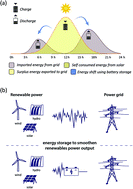High and intermediate temperature sodium–sulfur batteries for energy storage: development, challenges and perspectives
Abstract
In view of the burgeoning demand for energy storage stemming largely from the growing renewable energy sector, the prospects of high (>300 °C), intermediate (100–200 °C) and room temperature (25–60 °C) battery systems are encouraging. Metal sulfur batteries are an attractive choice since the sulfur cathode is abundant and offers an extremely high theoretical capacity of 1672 mA h g−1 upon complete discharge. Sodium also has high natural abundance and a respectable electrochemical reduction potential (−2.71 V vs. standard hydrogen electrode). Combining these two abundant elements as raw materials in an energy storage context leads to the sodium–sulfur battery (NaS). This review focuses solely on the progress, prospects and challenges of the high and intermediate temperature NaS secondary batteries (HT and IT NaS) as a whole. The already established HT NaS can be further improved in terms of energy density and safety record. The IT NaS takes advantage of the lower operating temperature to lower manufacturing and potentially operating costs whilst creating a safer environment. A thorough technical discussion on the building blocks of these two battery systems is discussed here, including electrolyte, separators, cell configuration, electrochemical reactions that take place under the different operating conditions and ways to monitor and comprehend the physicochemical and electrochemical processes under these temperatures. Furthermore, a brief summary of the work conducted on the room temperature (RT) NaS system is given seeking to couple the knowledge in this field with the one at elevated temperatures. Finally, future perspectives are discussed along with ways to effectively handle the technical challenges presented for this electrochemical energy storage system.

- This article is part of the themed collection: Battery development over the last decade


 Please wait while we load your content...
Please wait while we load your content...